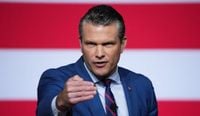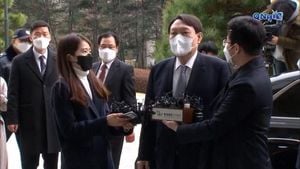Defense Secretary Pete Hegseth, a former Fox News host and Army officer, has found himself at the center of a storm within the Pentagon and beyond, as his leadership style, policy decisions, and recent public appearances have drawn fierce criticism and sparked debate about the direction of America’s military leadership.
On October 20, 2025, Hegseth took to the skies at Nevada’s Naval Air Station Fallon, cosplaying as Tom Cruise’s character from the iconic film Top Gun. He boarded an F/A-18 Super Hornet for a demonstration flight, while Joint Chiefs of Staff Chairman Gen. Dan Caine piloted his own F-16 fighter jet alongside. Hegseth made sure to publicize his “Top Gun moment” on social media, posting photos and a caption referencing the song “Danger Zone,” a nod to the 1986 movie’s soundtrack. According to The Daily Beast, videos posted by Hegseth’s deputy assistant showed the defense secretary climbing into the jet and, about an hour later, descending the aircraft’s ladder, visibly enjoying his moment in the limelight.
But not everyone was impressed. The stunt, coming amid an ongoing government shutdown and controversial U.S. military strikes in the Caribbean, was swiftly criticized as a frivolous use of time and resources. Dan Grazier, a Marine veteran and senior fellow at the Stimson Center, told The Washington Post, “There are better uses of his time than in a simulator and on training flights for what is effectively a stunt.” Grazier added, “Not only are we inflicting casualties, but American troops are also in harm’s way. So I would prefer our nation’s leaders are keeping a closer eye on the ball.”
Hegseth’s flight came just hours after he announced that the United States had conducted another strike on an alleged drug trafficking boat in international waters, resulting in three deaths. This operation is part of the Trump administration’s campaign against so-called “narcoterrorists” from Venezuela, a campaign that has thus far killed at least 32 people and ignited legal concerns and political backlash—even from within the Republican Party. GOP Senator Rand Paul, among others, has voiced criticism over the legality and morality of the strikes.
Back at the Pentagon, Hegseth’s tenure has been marked by turmoil and a growing sense of unease among top military brass. According to The Washington Times, senior officers and officials describe his leadership as unprofessional and damaging to the armed forces. The September 30 speech he gave at Marine Corps Base Quantico was cited by several high-ranking officers as a “massive waste of time” and “embarrassing.” Critics accuse Hegseth of operating with a “junior officer’s mentality,” obsessing over issues such as facial hair standards and media access while neglecting broader strategic concerns.
The shake-up at the Pentagon has been dramatic. Since taking office in January 2025, Hegseth has overseen the firing or early retirement of more than a dozen senior generals and admirals. Notably, former Joint Chiefs Chairman Gen. C.Q. Brown and former Chief of Naval Operations Adm. Lisa Franchetti were removed in February, while Air Force Chief of Staff Gen. David Allvin announced his retirement halfway through his term. Adm. Alvin Holsey of U.S. Southern Command is also planning to retire less than a year into his assignment. This exodus has left the Pentagon reeling, with current officers describing an atmosphere of fear and uncertainty, as talent “bleeds” from the services through firings, resignations, and early retirements.
Many officers allege that promotions and removals are often based on “favoritism” rather than merit, flying in the face of Hegseth’s repeated public commitment to creating a true meritocracy. As one officer put it, decisions are made for “unknown reasons,” fueling a sense of instability and mistrust. Further complicating matters, Hegseth’s inner circle has shrunk considerably, with sources saying he now relies almost exclusively on his spokesman Sean Parnell, his wife, and his brother, sidelining traditional Pentagon expertise.
Central to Hegseth’s agenda is his “warrior ethos” campaign—a drive to eliminate what he calls “woke” policies and to establish gender-neutral fitness standards across the military. While some in the ranks support certain elements, such as tougher fitness requirements and inspector general reforms, critics argue that Hegseth’s “theatrical delivery” is “below our institution.” During his Quantico speech, he reportedly told officers who disagreed with his priorities to resign, a move that only deepened the rift between his office and the broader officer corps.
Despite the criticism, Hegseth does have his supporters. They credit him with improving military recruiting and advancing technological initiatives, such as small tactical drone development and the proposed Golden Dome missile shield. Michael O’Hanlon of the Brookings Institution acknowledged Hegseth’s steadfast defense of U.S. alliances in the Asia-Pacific region and praised his efforts toward responsible budgeting. However, O’Hanlon also lamented the secretary’s focus on “culture wars,” calling it a distraction from more pressing defense priorities.
Hegseth’s approach to media relations has been especially contentious. Last week, he implemented new guidelines requiring journalists to publish only information expressly approved by the Pentagon—a move described as “unprecedented” and “restrictive.” The policy was met with near-universal rejection from news organizations across the political spectrum. Most Pentagon journalists surrendered their credentials rather than sign the new agreement, with The New York Times, The Washington Times, and even his former employer, Fox News, refusing to comply. Retired Gen. Jack Keane criticized the policy on Fox News, calling it an attempt to “spoon-feed information” to the public instead of allowing real journalism.
Hegseth’s leadership style has also come under fire from within. Staffers have described him as “manic” and “crawling out of his skin,” painting a picture of a leader under intense pressure and possibly struggling to maintain control. The fact that he was confirmed by the Senate by the narrowest of margins—51-50—amid allegations of misconduct only adds to the uncertainty surrounding his tenure.
As questions swirl about how long Pete Hegseth will remain in his position and what the long-term impact of his leadership will be on military readiness and morale, the Pentagon finds itself at a crossroads. Supporters point to tangible achievements in recruitment and modernization, while critics warn that chaos, fear, and a focus on personal theatrics are undermining the very foundations of American military strength.
For now, the nation’s defense establishment watches closely, uncertain whether the turbulence at the top will ultimately lead to lasting reform or lasting damage.




